[精选]初中英语阅读教学说课稿--资料
初中英语reading课说课稿
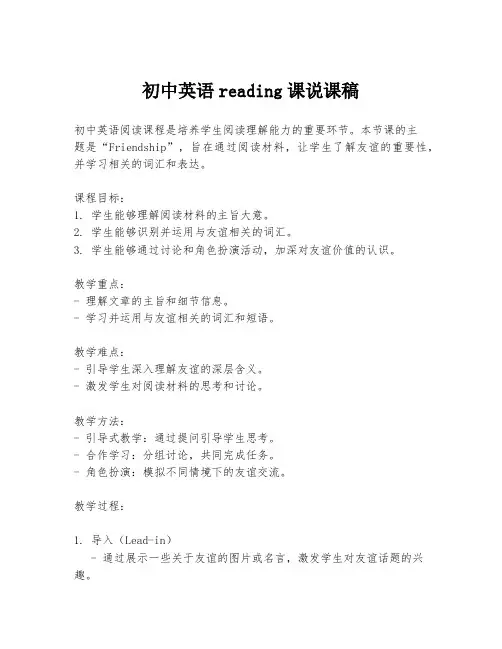
初中英语reading课说课稿初中英语阅读课程是培养学生阅读理解能力的重要环节。
本节课的主题是“Friendship”,旨在通过阅读材料,让学生了解友谊的重要性,并学习相关的词汇和表达。
课程目标:1. 学生能够理解阅读材料的主旨大意。
2. 学生能够识别并运用与友谊相关的词汇。
3. 学生能够通过讨论和角色扮演活动,加深对友谊价值的认识。
教学重点:- 理解文章的主旨和细节信息。
- 学习并运用与友谊相关的词汇和短语。
教学难点:- 引导学生深入理解友谊的深层含义。
- 激发学生对阅读材料的思考和讨论。
教学方法:- 引导式教学:通过提问引导学生思考。
- 合作学习:分组讨论,共同完成任务。
- 角色扮演:模拟不同情境下的友谊交流。
教学过程:1. 导入(Lead-in)- 通过展示一些关于友谊的图片或名言,激发学生对友谊话题的兴趣。
2. 词汇学习(Vocabulary Learning)- 教授与友谊相关的词汇,如:loyal, trust, support, etc.3. 阅读材料(Reading Material)- 向学生介绍阅读材料,确保他们理解材料的背景和主题。
4. 快速阅读(Skimming)- 让学生快速浏览文章,找出文章的主旨大意。
5. 细节理解(Scanning)- 通过提问,检查学生对文章细节的理解。
6. 深入讨论(In-depth Discussion)- 引导学生就友谊的不同方面进行讨论,如:友谊的意义,如何维持友谊等。
7. 角色扮演(Role Play)- 分组进行角色扮演,模拟友谊中的不同情境,如:解决朋友间的冲突。
8. 总结(Summary)- 总结本节课学到的知识点,强调友谊的重要性。
9. 作业布置(Homework Assignment)- 布置相关的阅读作业,要求学生阅读一篇关于友谊的文章,并写下自己的感受和理解。
通过本节课的学习,学生不仅能够提高自己的英语阅读能力,还能够对友谊有更深刻的认识和理解。
初中英语说课稿(最新9篇)
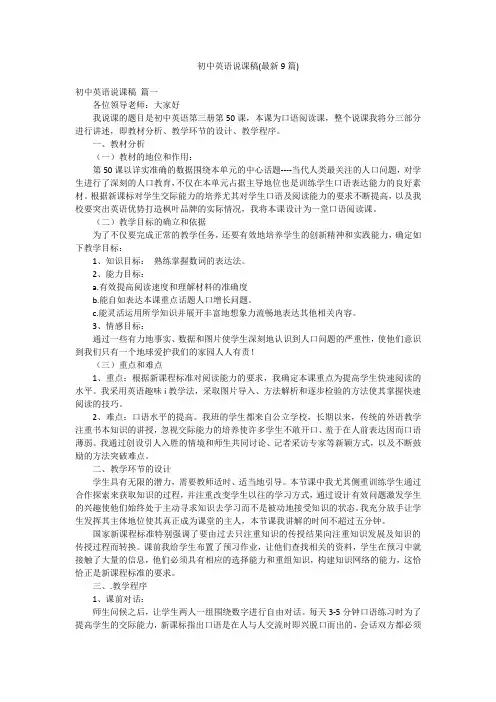
初中英语说课稿(最新9篇)初中英语说课稿篇一各位领导老师:大家好我说课的题目是初中英语第三册第50课,本课为口语阅读课,整个说课我将分三部分进行讲述,即教材分析、教学环节的设计、教学程序。
一、教材分析(一)教材的地位和作用:第50课以详实准确的数据围绕本单元的中心话题----当代人类最关注的人口问题,对学生进行了深刻的人口教育,不仅在本单元占据主导地位也是训练学生口语表达能力的良好素材。
根据新课标对学生交际能力的培养尤其对学生口语及阅读能力的要求不断提高,以及我校要突出英语优势打造枫叶品牌的实际情况,我将本课设计为一堂口语阅读课。
(二)教学目标的确立和依据为了不仅要完成正常的教学任务,还要有效地培养学生的创新精神和实践能力,确定如下教学目标:1、知识目标:熟练掌握数词的表达法。
2、能力目标:a.有效提高阅读速度和理解材料的准确度b.能自如表达本课重点话题人口增长问题。
c.能灵活运用所学知识并展开丰富地想象力流畅地表达其他相关内容。
3、情感目标:通过一些有力地事实、数据和图片使学生深刻地认识到人口问题的严重性,使他们意识到我们只有一个地球爱护我们的家园人人有责!(三)重点和难点1、重点:根据新课程标准对阅读能力的要求,我确定本课重点为提高学生快速阅读的水平。
我采用英语趣味i教学法,采取图片导入、方法解析和逐步检验的方法使其掌握快速阅读的技巧。
2、难点:口语水平的提高。
我班的学生都来自公立学校,长期以来,传统的外语教学注重书本知识的讲授,忽视交际能力的培养使许多学生不敢开口、羞于在人前表达因而口语薄弱。
我通过创设引人入胜的情境和师生共同讨论、记者采访专家等新颖方式,以及不断鼓励的方法突破难点。
二、教学环节的设计学生具有无限的潜力,需要教师适时、适当地引导。
本节课中我尤其侧重训练学生通过合作探索来获取知识的过程,并注重改变学生以往的学习方式,通过设计有效问题激发学生的兴趣使他们始终处于主动寻求知识去学习而不是被动地接受知识的状态。
初中英语阅读课说课稿范文英文版
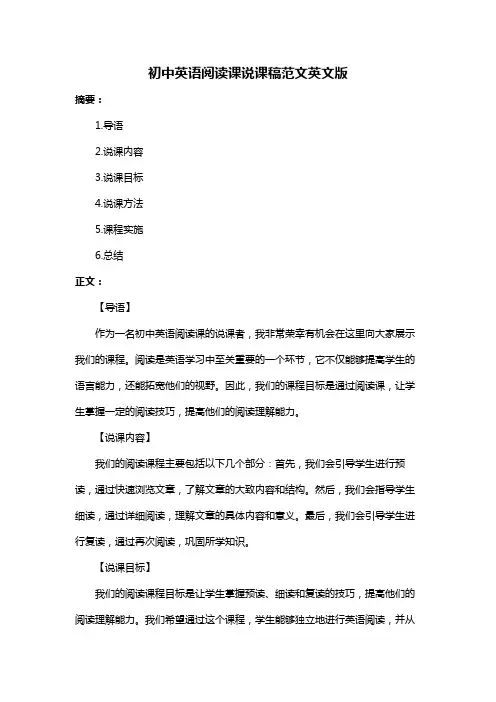
初中英语阅读课说课稿范文英文版
摘要:
1.导语
2.说课内容
3.说课目标
4.说课方法
5.课程实施
6.总结
正文:
【导语】
作为一名初中英语阅读课的说课者,我非常荣幸有机会在这里向大家展示我们的课程。
阅读是英语学习中至关重要的一个环节,它不仅能够提高学生的语言能力,还能拓宽他们的视野。
因此,我们的课程目标是通过阅读课,让学生掌握一定的阅读技巧,提高他们的阅读理解能力。
【说课内容】
我们的阅读课程主要包括以下几个部分:首先,我们会引导学生进行预读,通过快速浏览文章,了解文章的大致内容和结构。
然后,我们会指导学生细读,通过详细阅读,理解文章的具体内容和意义。
最后,我们会引导学生进行复读,通过再次阅读,巩固所学知识。
【说课目标】
我们的阅读课程目标是让学生掌握预读、细读和复读的技巧,提高他们的阅读理解能力。
我们希望通过这个课程,学生能够独立地进行英语阅读,并从
中获取知识和乐趣。
【说课方法】
为了达到我们的课程目标,我们将采用互动教学法,通过提问、讨论和练习等方式,引导学生积极参与,主动学习。
我们还会使用多媒体教学手段,如PPT、视频等,来丰富我们的教学内容,提高学生的学习兴趣。
【课程实施】
在课程实施过程中,我们会根据学生的实际情况,适时调整教学方法和内容。
我们会定期进行阅读理解练习,并对学生的学习进度进行跟踪和评估。
我们还会邀请一些英语专家来为我们的学生进行讲座,让他们更好地了解英语阅读的重要性和方法。
【总结】
总的来说,我们的初中英语阅读课程是一门旨在提高学生阅读理解能力的课程。
英语阅读课说课稿
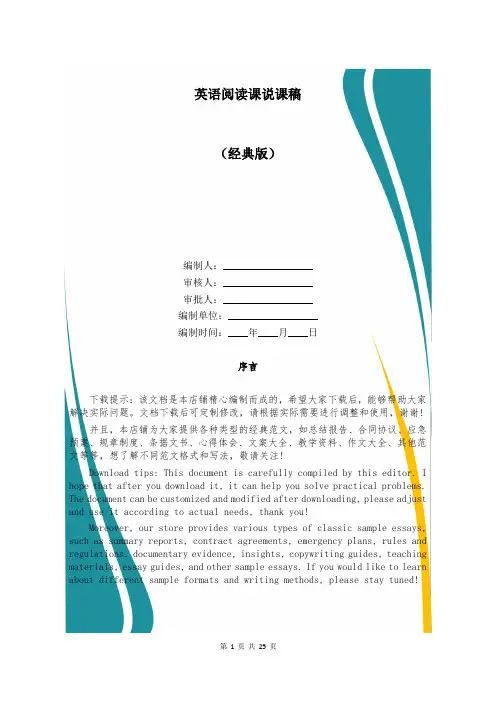
英语阅读课说课稿(经典版)编制人:__________________审核人:__________________审批人:__________________编制单位:__________________编制时间:____年____月____日序言下载提示:该文档是本店铺精心编制而成的,希望大家下载后,能够帮助大家解决实际问题。
文档下载后可定制修改,请根据实际需要进行调整和使用,谢谢!并且,本店铺为大家提供各种类型的经典范文,如总结报告、合同协议、应急预案、规章制度、条据文书、心得体会、文案大全、教学资料、作文大全、其他范文等等,想了解不同范文格式和写法,敬请关注!Download tips: This document is carefully compiled by this editor. I hope that after you download it, it can help you solve practical problems. The document can be customized and modified after downloading, please adjust and use it according to actual needs, thank you!Moreover, our store provides various types of classic sample essays, such as summary reports, contract agreements, emergency plans, rules and regulations, documentary evidence, insights, copywriting guides, teaching materials, essay guides, and other sample essays. If you would like to learn about different sample formats and writing methods, please stay tuned!英语阅读课说课稿英语阅读课说课稿(通用8篇)作为一名无私奉献的老师,通常需要用到说课稿来辅助教学,说课稿有助于提高教师理论素养和驾驭教材的能力。
初中英文说课稿
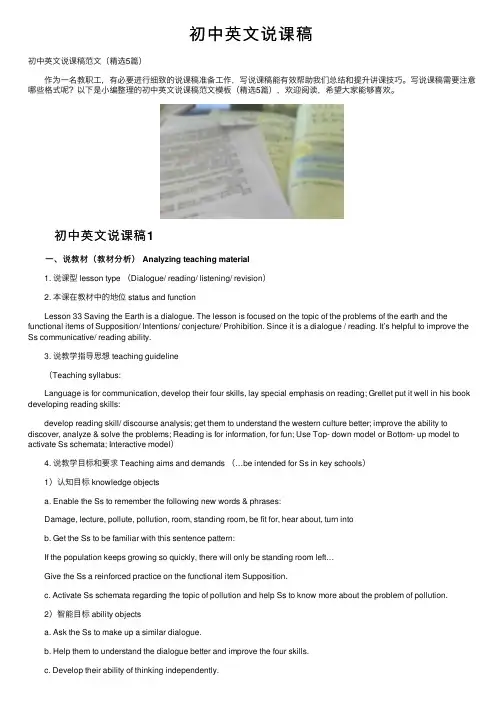
初中英⽂说课稿初中英⽂说课稿范⽂(精选5篇) 作为⼀名教职⼯,有必要进⾏细致的说课稿准备⼯作,写说课稿能有效帮助我们总结和提升讲课技巧。
写说课稿需要注意哪些格式呢?以下是⼩编整理的初中英⽂说课稿范⽂模板(精选5篇),欢迎阅读,希望⼤家能够喜欢。
初中英⽂说课稿1 ⼀、说教材(教材分析) Analyzing teaching material 1. 说课型 lesson type (Dialogue/ reading/ listening/ revision) 2. 本课在教材中的地位 status and function Lesson 33 Saving the Earth is a dialogue. The lesson is focused on the topic of the problems of the earth and the functional items of Supposition/ Intentions/ conjecture/ Prohibition. Since it is a dialogue / reading. It’s helpful to improve the Ss communicative/ reading ability. 3. 说教学指导思想 teaching guideline (Teaching syllabus: Language is for communication, develop their four skills, lay special emphasis on reading; Grellet put it well in his book developing reading skills: develop reading skill/ discourse analysis; get them to understand the western culture better; improve the ability to discover, analyze & solve the problems; Reading is for information, for fun; Use Top- down model or Bottom- up model to activate Ss schemata; Interactive model) 4. 说教学⽬标和要求 Teaching aims and demands (…be intended for Ss in key schools) 1)认知⽬标 knowledge objects a. Enable the Ss to remember the following new words & phrases: Damage, lecture, pollute, pollution, room, standing room, be fit for, hear about, turn into b. Get the Ss to be familiar with this sentence pattern: If the population keeps growing so quickly, there will only be standing room left… Give the Ss a reinforced practice on the functional item Supposition. c. Activate Ss schemata regarding the topic of pollution and help Ss to know more about the problem of pollution. 2)智能⽬标 ability objects a. Ask the Ss to make up a similar dialogue. b. Help them to understand the dialogue better and improve the four skills. c. Develop their ability of thinking independently. d. Cultivate their ability to discover, analyze and solve problems. e. Train them to collect information from the Internet. f. Train them with some effective learning methods to optimize Ss’ learning results. 3)德育⽬标 moral objects a. Arouse their interest in learning English; b. Help them to understand the background of pollution. c. Enable the students to love our earth and the nature. d. Be aware of the importance of stopping pollution & protecting our environment. e. Encourage the Ss to do something to save the earth. 5. 说教学重点 teaching important points (⽣词、句型;培养阅读技能) a. New words and phrases b. Sentence pattern: If- clause c. improve their reading skills. d. Talking about problems of the Earth. 6. 说教学难点 teaching difficult points (语法;发展交际能⼒) a. functional item: Supposition. b. Develop their communicative ability. Act out their own dialogue. 7. 说教具 teaching aids (multi-media computer, software, OHP) The teaching syllabus says that it’s necessary for teachers to use modern teaching facilities. It’s of great help to increase the class density and improve our teaching result. It can also make the Ss reach a better understanding of the text by making the classes lively and interesting. At the same time, it arouses the Ss’ interest in learning English. ⼆、说教法 Teaching methods Five step method; audio-video; communicative approach; Task-based learning: New Syllabus Design encourages teachers to use this teaching method. TBLT can stimulate Ss’ initiative in learning and develop their ability in language application. Make the Ss the real masters in class while the teacher himself acts as the director and bring their ability into full play. 三、说学法 Study methods 1. Teach Ss how to be successful language learners. 2. Teach Ss how to develop the reading skill — skim & scan; how to communicate with others; how to learn new words; how to learn independently; 3. Get the Ss to form good learning habits. 四、说教学过程Teaching procedures I. 复习(Revision) 5min (Daily report; 词汇diagram; brainstorming; activate schemata) Activity 1: Imagination 1) Suppose a bottle of ink is turned over and dirties your white shirt, what is to be done? (Wash it? Or throw it away?) 2) Suppose you catch a bad cold, what’s to be done? 3) Suppose your bike is broken, what’s to be done? 4) And suppose the earth, on which we all live, is damaged, what’s to be done? * What can you think of when you see "pollution" this word?(waste, environment, air, water, factory, desert, climate…Try to activate the Ss schemata regarding the topic of pollution.) II. 呈现(Presentation) 5min Activity 2: Presentation Play the song "Earth Song" sung by Michael Jackson. (Create an atmosphere) A lot of pictures and video clips about the causes and results of the three problems mentioned in this lesson will be shown on the screen with the help of the computer. Ss’ presentation on pollution. Attract their attention, arouse their interest, and create a good atmosphere for communication. * Activate their schemata and cultivate their ability in collecting information from the Internet and develop their ability in thinking independently. III. 对话 / 阅读(Dialogue)18m 1. Pre- reading Activity 3: Prediction 1st listening/ fast reading, one guided Q to help Ss to get the main idea: What do you think is discussed at the conference? 2. While- reading Activity 4: Read and answer 2nd listening/ careful reading, more Qs to get the detailed information. Develop their reading skills: skim & scan. Pay attention to the pronunciation, stress & intonation. * 阅读: Pre-reading; while-reading; post-reading (fast reading/ careful reading; skim/ scan; 识别关键词key words;确定主题句;创设信息差information gap;T or F; 填表格chart/diagram; Predicting; Make a timeline; Make a story map.达到对课⽂的`整体理解和掌握。
初二英语说课稿(精选5篇)
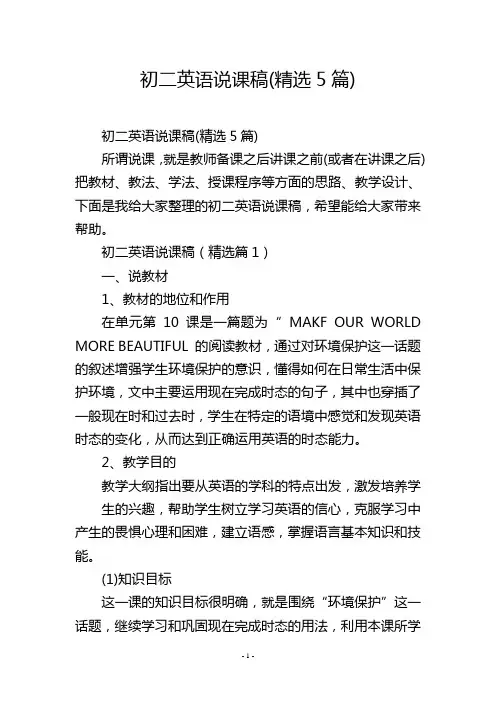
初二英语说课稿(精选5篇)初二英语说课稿(精选5篇)所谓说课,就是教师备课之后讲课之前(或者在讲课之后)把教材、教法、学法、授课程序等方面的思路、教学设计、下面是我给大家整理的初二英语说课稿,希望能给大家带来帮助。
初二英语说课稿(精选篇1)一、说教材1、教材的地位和作用在单元第10课是一篇题为“MAKF OUR WORLD MORE BEAUTIFUL 的阅读教材,通过对环境保护这一话题的叙述增强学生环境保护的意识,懂得如何在日常生活中保护环境,文中主要运用现在完成时态的句子,其中也穿插了一般现在时和过去时,学生在特定的语境中感觉和发现英语时态的变化,从而达到正确运用英语的时态能力。
2、教学目的教学大纲指出要从英语的学科的特点出发,激发培养学生的兴趣,帮助学生树立学习英语的信心,克服学习中产生的畏惧心理和困难,建立语感,掌握语言基本知识和技能。
(1)知识目标这一课的知识目标很明确,就是围绕“环境保护”这一话题,继续学习和巩固现在完成时态的用法,利用本课所学习的话题,把功能与语法教学紧密结合一起。
(2)能力目标本课首先利用课前问题(pre-reading questions ),启发学生利用已有的知识经验,对课文内容进行预测,就有关话题开展讨论,通过阅读验证自己的推测,吸取信息,掌握新的知识,丰富经验,从而达到独立阅读的能力。
3、教材的重点、难点、关键(1)重点:本课重点在其运用完成时态的句子谈论环保这一话题。
(2)难点:对课文内容及时态含义的理解。
(3)关键:在于是否能突破难关,达到正确运用完成时态表达句意、理解全文的目标。
初二英语说课稿(精选篇2)一、说教材(一)、教材的地位和作用本单元以How do you get to school?为中心话题,围绕交通方式而展开,主要运用How long/How far 询问“去某地的交通方式、时间、距离。
”简单描述路线。
这一话题贴近学生们的日常生活,它继第三单元谈论“假日计划”后安排这样一个话题,符合学生的认知结构和年龄特征,它将为后几个单元的学习打下坚定的语言基础。
初三英语阅读课的说课稿
初三英语阅读课的说课稿在准备初三英语阅读课的说课稿时,我们需要考虑课程目标、教学内容、教学方法、学生特点以及课堂互动等方面。
以下是一个初三英语阅读课的说课稿示例:初三英语阅读课说课稿一、课程目标本节课旨在帮助学生提高英语阅读理解能力,培养他们分析和解决问题的能力。
通过阅读材料,学生将学习到如何快速捕捉文章主旨,理解细节信息,并能够对文章进行批判性思考。
二、教学内容1. 阅读材料:选取适合初三学生水平的英语短文,内容涵盖日常生活、科学探索、文化差异等主题。
2. 词汇学习:教授与阅读材料相关的新词汇,帮助学生扩大词汇量。
3. 阅读技巧:教授学生如何通过关键词定位信息,如何进行归纳总结,以及如何进行推理判断。
三、教学方法1. 引导式教学:通过提问引导学生思考,激发他们的阅读兴趣。
2. 分组讨论:让学生在小组内讨论文章内容,培养他们的合作精神和交流能力。
3. 角色扮演:让学生扮演文章中的角色,加深对文章内容的理解。
4. 思维导图:引导学生使用思维导图整理文章结构,帮助他们更好地把握文章脉络。
四、学生特点初三学生正处于语言学习的关键期,他们对新知识有较强的好奇心和求知欲。
同时,他们的抽象思维能力逐渐增强,能够进行更深层次的思考。
五、课堂互动1. 互动问答:在阅读过程中,教师提出问题,学生进行回答,以检验他们的理解程度。
2. 小组竞赛:通过小组竞赛的形式,激发学生的学习热情,提高课堂的活跃度。
3. 反馈与评价:在课堂结束时,收集学生的反馈,对他们的表现进行评价,以便于调整教学策略。
六、课后作业布置与阅读材料相关的作业,如写一篇读后感,或者对文章中的某个观点进行论述,以巩固学生在课堂上学到的知识。
七、教学反思课后,教师需要反思教学过程中的得失,思考如何改进教学方法,以更好地满足学生的学习需求。
通过这样的说课稿,教师可以清晰地规划课程内容和教学流程,确保教学活动的有效性。
同时,也能够根据学生的反馈和学习效果,不断调整和优化教学策略。
初三英语阅读理解说课稿
初三英语阅读理解说课稿一、教学目标1. 知识目标:学生能够理解并掌握阅读材料中的生词、短语和语法结构。
2. 技能目标:提高学生的阅读速度和理解能力,能够从不同文体的阅读材料中提取关键信息。
3. 情感目标:激发学生对英语阅读的兴趣,培养他们自主学习的习惯。
二、教学重点1. 词汇理解:教授学生如何通过上下文来猜测生词的意思。
2. 主旨大意:训练学生快速抓住文章的主旨大意。
3. 细节理解:指导学生如何寻找并理解文章中的细节信息。
三、教学难点1. 长难句分析:帮助学生理解并分析长难句的结构。
2. 推理判断:培养学生的推理判断能力,能够根据文章内容做出合理的推断。
四、教学方法1. 引导式教学:通过提问引导学生思考,激发他们的好奇心和求知欲。
2. 合作学习:鼓励学生小组讨论,共同解决阅读理解中的问题。
3. 任务型教学:设置具体的阅读任务,让学生在完成任务的过程中提高阅读能力。
五、教学过程1. 导入新课:通过与学生的日常对话,引入阅读材料的主题。
2. 词汇学习:教授阅读材料中的生词和短语,让学生理解其在文中的含义。
3. 快速阅读:让学生快速浏览文章,找出主旨大意。
4. 细读理解:指导学生细读文章,理解文章的细节和深层含义。
5. 问题讨论:提出问题,让学生通过小组讨论来寻找答案。
6. 总结反馈:总结学生在阅读中遇到的问题,给予反馈和指导。
六、教学资源1. 阅读材料:选择适合初三学生水平的英语阅读材料。
2. 多媒体工具:使用多媒体工具辅助教学,如PPT、视频等。
七、作业布置1. 阅读理解练习:布置与课堂内容相关的阅读理解练习。
2. 词汇复习:要求学生复习课堂中学到的生词和短语。
八、板书设计- 主题:[阅读材料标题]- 词汇:[列出阅读材料中的生词和短语]- 主旨大意:[文章的主旨大意]- 关键点:[文章中的关键信息点]此说课稿旨在为教师提供一个教学框架,以确保学生能够在英语阅读理解方面取得进步。
教师可以根据实际情况调整教学内容和方法。
初中英语阅读文章说课稿
初中英语阅读文章说课稿初中英语阅读教学是培养学生英语综合运用能力的重要环节。
一篇好的阅读文章不仅能够提高学生的阅读兴趣,还能在语言学习的同时,拓宽学生的视野,培养他们的批判性思维能力。
以下是一份初中英语阅读文章的说课稿。
# 教学目标1. 知识与技能:使学生能够理解文章的主旨大意,掌握文章中的关键词汇和句型结构。
2. 过程与方法:通过阅读策略的指导,提高学生的阅读速度和理解能力。
3. 情感态度与价值观:激发学生对英语阅读的兴趣,培养他们自主学习的习惯。
# 教学内容本次阅读文章的标题为《A Day in the Life of a Bee》,文章通过描述蜜蜂一天的生活,向学生介绍了蜜蜂的习性和它们在生态系统中的重要性。
# 教学重点1. 理解文章的主旨大意。
2. 学习并掌握文章中的关键词汇,如“honeybee”, “nectar”, “pollen”, “hive”等。
3. 理解并运用文章中出现的重点句型。
# 教学难点1. 文章中出现的一些专业词汇和复杂句型的理解。
2. 培养学生的批判性思维,引导他们思考蜜蜂对环境的影响。
# 教学方法1. 导入新课:通过展示蜜蜂的图片或视频,激发学生的兴趣,引入话题。
2. 整体感知:让学生快速阅读文章,把握文章的主旨大意。
3. 细节理解:通过提问和讨论,帮助学生理解文章中的细节信息。
4. 词汇学习:教授文章中的关键词汇,并通过造句练习加深理解。
5. 句型操练:通过填空、转换句型等方式,让学生熟练掌握重点句型。
6. 思维拓展:引导学生思考蜜蜂在自然界中的角色,以及它们面临的威胁。
# 教学过程1. 导入:展示蜜蜂的图片,询问学生对蜜蜂的了解。
2. 预读:快速浏览文章,回答关于文章主旨的问题。
3. 精读:细读文章,找出并讨论文章中的关键信息和词汇。
4. 词汇教学:教授并练习文章中的关键词汇。
5. 句型练习:通过各种练习,让学生掌握文章中的句型结构。
6. 思维拓展:讨论蜜蜂对环境的影响,以及我们如何保护它们。
初中英语阅读课说课稿范文英文版
初中英语阅读课说课稿范文英文版摘要:I.引言- 介绍初中英语阅读课说课稿的背景和目的II.教学材料分析- 分析教材的地位和作用- 介绍教学材料的内容和主题III.教学目标- 明确教学目标- 介绍教学目标的具体内容IV.教学策略- 阐述教学策略- 描述教学过程中的关键步骤V.教学评价- 说明教学评价的方法和标准- 分析教学效果和反思VI.总结- 回顾教学设计和实施过程- 提出改进和优化建议正文:I.引言初中英语阅读课是英语教学的重要组成部分,旨在培养学生的英语阅读能力,扩大词汇量和提高语法水平。
本篇说课稿旨在提供一个初中英语阅读课的教学设计和实施过程的参考范例。
II.教学材料分析本节课所使用的教材是一篇关于环保的英语文章。
该文章主题鲜明,内容丰富,既涵盖了环保问题的现状,又提出了具体的解决措施。
通过阅读这篇文章,学生可以了解到环保的重要性,提高自己的环保意识。
III.教学目标本节课的教学目标是培养学生的英语阅读能力,具体包括以下几点:1.学生能理解文章的主旨和关键信息;2.学生能识别和运用文章中的重要词汇和短语;3.学生能分析文章的句子结构和语法特征;4.学生能根据文章内容进行合理的推断和猜测。
IV.教学策略为了实现教学目标,本节课将采用以下教学策略:1.导入法:通过图片和问题引导学生进入课堂,激发学生的学习兴趣;2.阅读法:指导学生运用略读、寻读等阅读技巧,快速捕捉文章关键信息;3.讲解法:针对文章中的难点和重点,进行详细的解释和说明;4.练习法:通过填空、选择、问答等形式,检查学生的阅读理解能力;5.讨论法:组织学生进行小组讨论,分享阅读心得和环保建议。
V.教学评价教学评价将采用以下方法和标准:1.学生课堂表现:观察学生在讨论、提问等方面的积极性;2.学生阅读理解能力:通过练习题和小组汇报,评估学生的阅读效果;3.学生环保意识:了解学生在课后实践环保行动的情况。
VI.总结总之,本节课通过有效的教学策略,帮助学生实现了英语阅读能力的提升。
- 1、下载文档前请自行甄别文档内容的完整性,平台不提供额外的编辑、内容补充、找答案等附加服务。
- 2、"仅部分预览"的文档,不可在线预览部分如存在完整性等问题,可反馈申请退款(可完整预览的文档不适用该条件!)。
- 3、如文档侵犯您的权益,请联系客服反馈,我们会尽快为您处理(人工客服工作时间:9:00-18:30)。
说课稿
Good morning,my dear judges.I am (No.6).It is a great honor to have a chance to stand here and talk to you today.The lesson I'm going to talk about is from Unit 4 in Grade (8 )Book( 2) of Go for it.section ( A)s reading .Now I will explain [ik'splein] the from the following aspects.
Firstly,Teaching Aims:
According to the new English Curriculum [kə'rikjuləm] standards and the teaching content,I make the following teaching aims. The first one is knowledge aims(一、知识目标).by the end of the lesson,students will be able to Learn and master new words, phrases( ) and sentence patterns( ).The second one is competence ['kɔmpitəns] aims(二、技能目标).by the end of the lesson,Enable students to talk in English about (how to study English very wel l).The third one is emotional [i'məuʃənəl] aims(三、情感目标).by learning of this lesson,stimulate['stimjuleit]students interest in learning English.Enable students to establish confidence in learning English.Cultivating ['kʌltiveit] students ability of English expression[ik'spreʃən]
and develop students speaking and writing ability. Secondly,Teaching key Points:
First , Improve the students’ speaking and writing ability. Second, Master some phrases( ) and some sentence patterns.( )
Thirdly,. Teaching Difficult Points:
1. Phrases:(短语)
(first of all, later on, laugh at, take notes)
2. Sentence Patterns:(句型)
Sb. be afraid to do sth.
Sb. realize that –clause
Fourthly,Teaching Methods:
1. Fast reading to find out the general information about the passage.
2. Question-and-answer activities to help the students to go
through the whole passage.
3. Individual, pair and group work to make every student work in class.
Fifthly. Teaching Aids: (教具)
The blackboard PPT
Sixthly Teaching Procedures:In order to achieve the above goal of teaching,Idesign[di'zain]the teaching
procudures.
The Blackboard Design:教学设计理念。
